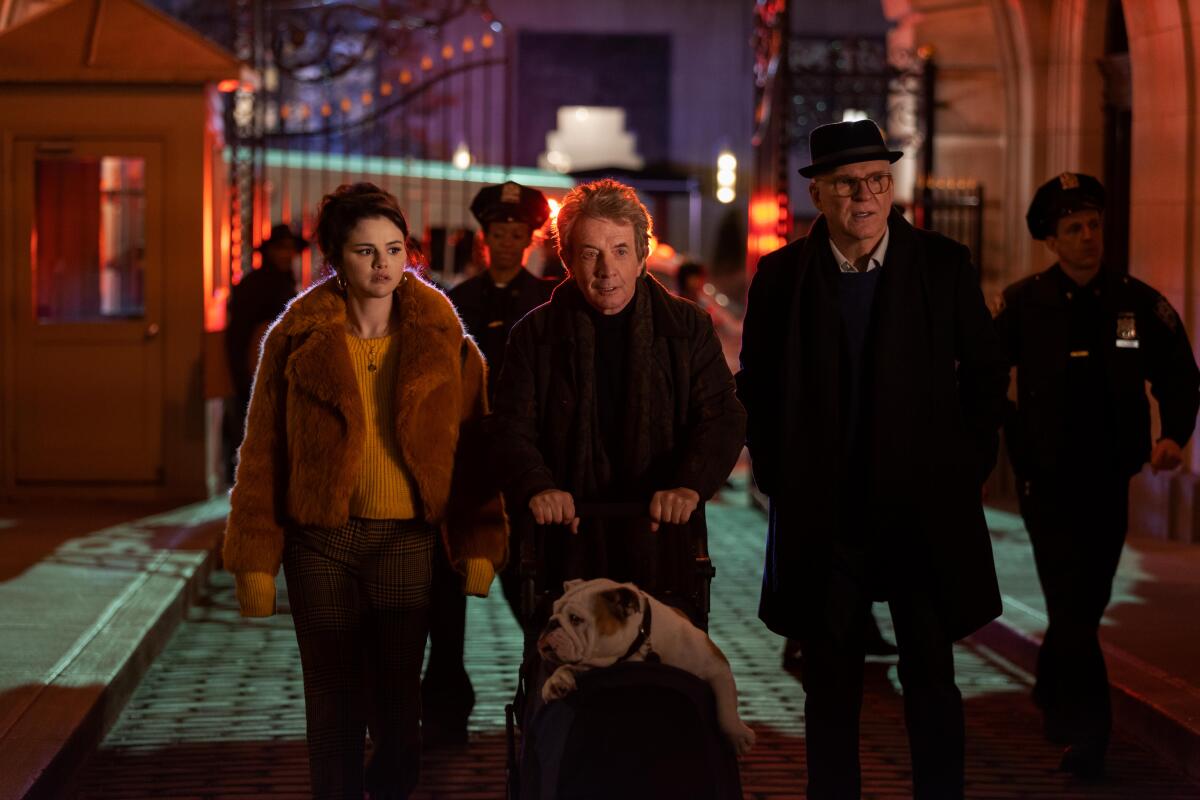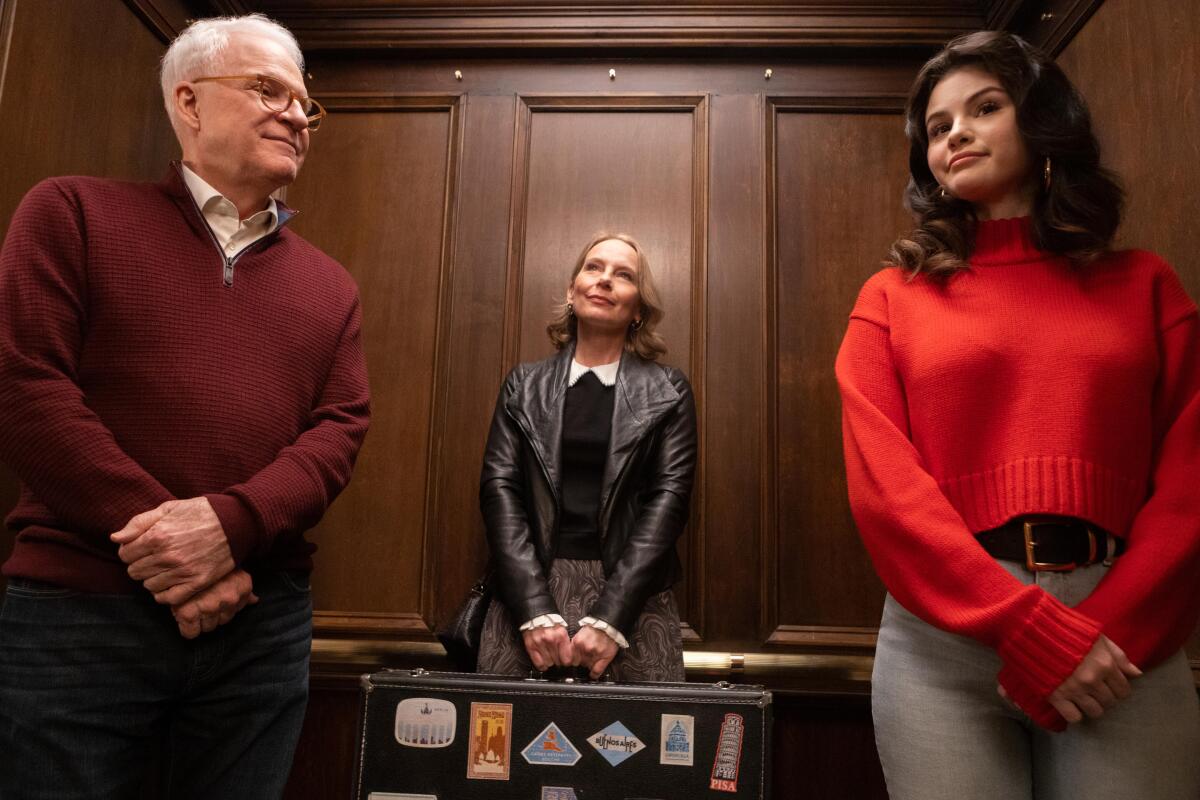What ‘Only Murders in the Building’ gets right about our obsession with true crime

- Share via
The following story contains spoilers from Episode 8 of “Only Murders in the Building,” “Fan Fiction.”
I rarely see myself represented on-screen, but there I was this week — as I am every week — at the center of the narrative in Hulu’s comedy “Only Murders in the Building.”
No, the show is not about an Arab American Angeleno with a soft spot for pit bull rescues and the occasional Pitbull single. Hulu’s murder mystery series follows three true crime fans, all more or less strangers until the untimely death of a tenant in their tony Manhattan apartment building, the Arconia. They bond in an effort to solve the crime and end up making a whodunit podcast in the process.
The complete guide to home viewing
Get Screen Gab for everything about the TV shows and streaming movies everyone’s talking about.
You may occasionally receive promotional content from the Los Angeles Times.
Those of us who consume podcasts like “Serial,” binge-watch A&E’s “The First 48,” or devour documentaries like Netflix’s “Night Stalker: The Hunt for a Serial Killer” or HBO’s “The Jinx: The Life and Deaths of Robert Durst” can’t help but see ourselves in the show’s sleuthing protagonists, Charles (Steve Martin), Oliver (Martin Short) and Mabel (Selena Gomez). They know the victim, Tim Kono (Julian Cihi), did not take his own life, as the police have ruled. They just have to prove it — using skills they’ve honed as armchair detectives and ardent listeners of the (fictional) true crime podcast “All Is Not Okay in Oklahoma,” hosted by Tina Fey’s Cinda Canning. They want to get to the bottom of what happened to Tim, and they want accountability: two of the main reasons I waste so much damn time watching shows like “Cold Justice” and “American Detective.”

Tuesday’s episode, “Fan Fiction,” features the hardcore followers of the “Only Murders in the Building” podcast, whom Oliver invites into the building to help goose their stalled investigation. The fresh crew represents next-level obsessiveness — devotees who camp outside the Arconia waiting for the next episode. They call themselves Arconiacs, Mabellines and Hayden’s Maidens. They repeatedly scour each episode for overlooked clues and dissect crumbs for the slightest chance of a new lead: Tim got on the elevator on the sixth floor with a trash bag the night of his death, but he lived on the eight floor. Was he carrying his own garbage or someone else’s? The logistics and timing of the fire alarm that night point to more than one killer.
They are the far end of the true crime-fiend spectrum, the type of fanatics featured in the Netflix documentary “Don’t F**k With Cats” or “Crime Scene: The Vanishing at the Cecil Hotel.” They’re reminiscent of internet gumshoes who inspect the grainy corners of surveillance videos for evidence or Facebook pages for hints to a suspect’s location (“That type of electrical outlet is only used in one Canadian province.”). Or the self-styled Sherlocks of the still-unresolved case of Gabby Petito, which found social media followers piecing together the missing woman’s cross-country trek with fiancé Brian Laundrie before the hunt ended in tragedy with the discovery of her body on Sept. 19. Since then, the puzzle has continued to generate reams of internet-spun theories — mostly from nonexperts who should have something better to do with their time — about the whereabouts of prime suspect Laundrie, who remains at large.
Times TV critic and avid true-crime watcher Lorraine Ali highlights the films and TV series to keep an eye on this fall.
The genius of the show is its willingness to navigate the gradations of true-crime culture, from mild enthusiasts to dangerous zealots. It has fun with the fascination around crime-solving fare, but it takes a more critical tone when depicting the desperadoes who insert themselves into cases — and the hassle they can cause investigators, exemplified by Da’Vine Joy Randolph‘s exasperated detective. By the end of this week’s episode, it turns out that the theory the “Only Murders” superfans helped devised is wrong: The Dimas family did not kill Kono. “Real life doesn’t always resolve like mysteries do,” one says in voice-over.
But the series also resists the urge to look down on my (maybe occasionally trashy) bingeing habits. I’ve spent countless hours watching and listening to investigations, from Netflix’s “Monsters Inside: The 24 Faces of Billy Milligan” to Peacock’s “Dr Death: The Undoctored Story.” It’s morbid, I know. But it’s one slice of televised reality where avengers who are not superheroes sometimes achieve justice and, as rarely happens in cases of political corruption or corporate crime, there’s the possibility of accountability if the culprit is caught.
Ultimately, the show, co-created by Martin and John Hoffman, pokes fun at the proliferation of true crime docuseries and podcasts while spinning its own compelling mystery for viewers to solve. They had me in the first few minutes of the premiere episode, when Mabel describes her city as “a place that makes you binge ‘Dateline’ to find out how not to end up on ‘Dateline.’”
She also nails the therapeutic side of consuming lots of true crime when she describes a recurring dream she has: “I wake up and there’s a man standing over me. So I kick him right in the nuts and grab my knitting needle and I take him down to the bone with that thing. Sometimes when I can’t sleep, I imagine brutally murdering that dude and I’m out like a light. Works every time.”
Finally. A show that gets me.
‘Only Murders in the Building’
Where: Hulu
When: Any time, new episodes on Mondays
Rating: TV-MA (may be unsuitable for children under the age of 17)
More to Read
The complete guide to home viewing
Get Screen Gab for everything about the TV shows and streaming movies everyone’s talking about.
You may occasionally receive promotional content from the Los Angeles Times.








